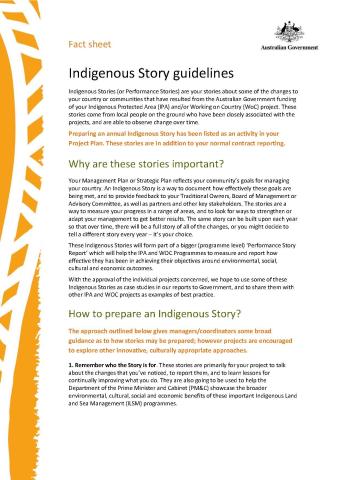Indigenous Story guidelines - Fact sheet
These guidelines are to assist coordinators of Indigenous ranger teams to prepare Indigenous Stories (Performance Stories) about some of the changes to country or communities that have resulted from Australian Government Funding.
Indigenous Story guidelines
Indigenous Stories (or Performance Stories) are your stories about some of the changes to your country or communities that have resulted from the Australian Government funding of your Indigenous Protected Area (IPA) and/or Working on Country (WoC) project. These stories come from local people on the ground who have been closely associated with the projects, and are able to observe change over time.
Preparing an annual Indigenous Story has been listed as an activity in your Project Plan. These stories are in addition to your normal contract reporting.
Why are these stories important?
Your Management Plan or Strategic Plan reflects your community’s goals for managing your country. An Indigenous Story is a way to document how effectively these goals are being met, and to provide feedback to your Traditional Owners, Board of Management or Advisory Committee, as well as partners and other key stakeholders. The stories are a way to measure your progress in a range of areas, and to look for ways to strengthen or adapt your management to get better results. The same story can be built upon each year so that over time, there will be a full story of all of the changes, or you might decide to tell a different story every year – it’s your choice.
These Indigenous Stories will form part of a bigger (programme level) ‘Performance Story Report’ which will help the IPA and WOC Programmes to measure and report how effective they has been in achieving their objectives around environmental, social, cultural and economic outcomes.
With the approval of the individual projects concerned, we hope to use some of these Indigenous Stories as case studies in our reports to Government, and to share them with other IPA and WOC projects as examples of best practice.
How to prepare an Indigenous Story?
The approach outlined below gives managers/coordinators some broad guidance as to how stories may be prepared; however projects are encouraged to explore other innovative, culturally appropriate approaches.
1. Remember who the Story is for. These stories are primarily for your project to talk about the changes that you’ve noticed, to report them, and to learn lessons for continually improving what you do. They are also going to be used to help the Department of the Prime Minister and Cabinet (PM&C) showcase the broader environmental, cultural, social and economic benefits of these important Indigenous Land and Sea Management (ILSM) programmes. Fact sheet
2. Decide who pulls the story together. This could be an experienced staff or community member with appropriate skills and knowledge of your project and the people involved, or an external consultant. Funds can be allocated from your project to do this.
3. Decide what story you are going to tell. Identify an area of significant change that relates to your management objectives (e.g. look among the 5 top things listed in your Management Plan or Strategic Plan). Your story might also address one of the Australian Government’s Indigenous Advancement Strategy objectives around adults in jobs, kids at school, and safe communities.
Don’t forget that change can be small or large, and ‘good’ or ‘not so good’. Sometimes it’s helpful to tell stories that show how a project has learned from its mistakes.
4. Develop some key questions. These can prompt people involved in the project in capturing the story. Consider how the questions may be translated and understood in local language/s.
For example: How has the ....(area of interest).... changed as a result of the IPA/WOC project? What evidence do you have of this change? How has it benefited the community?
Make questions broad and open, and appropriate for your project and your community.
5. Ask questions from a range of participants. This could include your Indigenous Rangers, Traditional Owners and community members, and perhaps partners in your project such as local industry groups, government agencies, NGOs, and researchers.
6. Decide how the Story will be presented. Stories can be written (including quotes), oral (e.g. through video), art-based (through painting or a collection of images), or a recorded performance such as a dance. Innovation and culturally based presentations are also encouraged.
Stories could include numerical (factual) data as well as yarns (personal anecdote).
7. Review the stories and see how you can learn from them. Share the lessons with your Management Board or Advisory Committee, partners and local community. Use these lessons to inform your future planning.
Key dates. We are asking projects to submit an outline of what they are proposing to do by 3 February each year (the date that mid-year reports are due). Your PM&C project manager will provide feedback to help you prepare your final story which is due at the end of June to allow the Department to prepare a timely annual review of these ILSM programmes.
Your feedback is welcome
This Indigenous Story telling is a new approach to measuring and reporting on the progress of IPA and WOC projects and the programmes as a whole, and to improving performance at each level. Any feedback on these guidelines would be very welcome.
